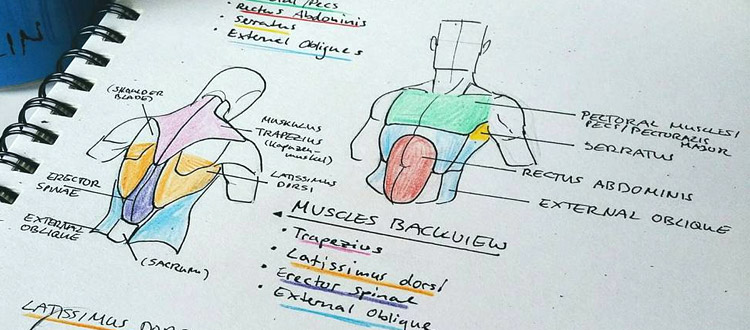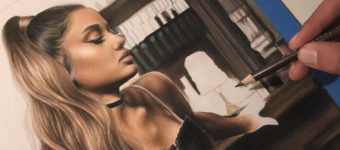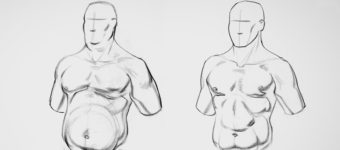
Top 10 Human Anatomy Books For Artists
If you want to learning to draw well you’ll have to study human anatomy. You should practice a lot of life drawing sessions with long-form poses and quick gestures.
But drawing from life is only half the battle. You also need a deep knowledge of the human anatomy to construct muscles, bones, and joints in a realistic fashion. You can learn by memorizing the figure, but anatomy books have much more information and they’re easier to access.
In this post I’ve collected the 10 best anatomy books for artists. This includes raw anatomical dictionaries along with more stylized books to go along with the rote memorization.
As such I’ve broken down this post into two sections: first is raw anatomy books and second is more ancillary content to aid your studies & life drawing efforts.
Core Anatomy Books
Every artist should have at least one core anatomy book. This is the cornerstone of self-study and a book full of anatomy info will be crucial the more you practice life drawing.
If you want multiple references I’d obviously encourage that too.
But most people just need one solid book and in that case I’d suggest one from this list.
Atlas of Human Anatomy for the Artist


One of the most recommended books for mastering the figure is Atlas of Human Anatomy for the Artist. It comes with 272 pages full of illustrations showing the bones, muscles, tendons, and how they all connect.
Every artist needs to know this stuff and sometimes a technical book is the best way to go.
You’ll learn about the differences in human anatomy when it comes to kids, adults, men & women, plus different body sizes. You learn by studying from real photos and illustrations that demonstrate how to render anatomical parts accurately.
While this does make an amazing reference manual it does not work as a teaching tool.
You won’t learn figure drawing from this book. However it will show you the human figure from a technical point of view—a valuable thing for every artist to understand.
Human Anatomy for Artists: The Elements of Form


Eliot Goldfinger is the author of Human Anatomy for Artists and this tome of anatomy is my #1 recommendation for artists.
I’ll start by saying this book is dense. It totals 368 pages and it covers almost every aspect of the human anatomy. Even though the book’s title says it’s for artists, the whole thing can feel like a science journal.
I wouldn’t sit down and read this for fun but I would(and do) frequently reference this as a study guide. Nobody can learn anatomy all in one sitting so you’ll constantly be learning more as you go.
Human Anatomy for Artists could be the only book you ever own on human anatomy.
It covers everything like bones, muscles, fascia, tendons/ligaments, and joints, plus photos to help you understand each part along the way.
This book does not have bodies in flexed poses so it can feel rather static. But for a terse anatomical reference guide to the human figure I cannot think of a better book.
Anatomy for the Artist


One reason you’d get this book is to just learn about human anatomy. Another reason is to study the hi-res photos and use these as references for your own drawings.
Anatomy for the Artist contains 200+ pages of color photos and diagrams that overlay these photos. You can see layers of bones, muscles, and fascia as they form beneath the skin. Each photo is very high quality so you’ll have no problem studying the content.
However I don’t think this book is as detailed as the previous one by Goldfinger.
I would almost say that Anatomy for the Artist acts more like a coffee table book for human anatomy rather than a detailed reference guide.
The transparent overlays are very fun and they can help you visualize how to see the figure accurately. But this book probably won’t help you master all the small intricacies like you get with Human Anatomy for Artists.
Anatomy For Sculptors Series


This series takes a detailed look at individual body parts which get split up into different books. I’d imagine that most artists don’t want to pay extra for individual anatomy books.
But the upside is that you can grab Anatomy For Sculptors based on exactly what you need whether it’s the torso, upper limbs, lower limbs, or the face & neck muscles.
Each book goes into detail about the construction and behavior of each part of the body. The content is geared towards 3D sculptors but the writing is so detailed that it easily applies to 2D artists and illustrators too.
Note these books are surprisingly short and they’re mostly available in digital Kindle formats. I wouldn’t recommend this entire set as a replacement for any other anatomy book.
However if you need to brush up on a single area of the human anatomy then you might grab one specific book from this series.
Anatomy: A Complete Guide for Artists


I like a lot of the Dover books because they’re often very high quality and surprisingly affordable. Anatomy: A Complete Guide for Artists is a somewhat older book dating back to the early 1990s.
Thankfully the human figure hasn’t changed much since the late 20th century so all the information is still applicable.
The author doesn’t teach anatomy from a point of forced memorization. Instead you get a series of exercises based on individual parts of the body like the arms, legs, torso, etc. You’ll have sketches and more refined drawings for each chapter to help you see how these anatomical details should be rendered.
The author Joseph Sheppard is a renowned artist with decades of experience. His writing style is quick yet accurate.
Sheppard’s goal is to help you learn anatomy through exercise and a bit of memorization. But this book is much easier to understand if you’ve made it through other anatomy books in the past.
Ancillary Books
Aside from core anatomy books I’d also recommend getting figure/anatomy books. These don’t help you memorize the pure anatomy, but they can teach anatomy along with techniques for figure drawing.
These are my favorite figure books that touch upon anatomy and work well in conjunction with an anatomy reference guide.
Complete Guide to Life Drawing


This is the newest book in my post and the material really shows. The author Gottfried Bammes covers a wide variety of content from body types, ages, sexes, and even proportions for different body types.
Complete Guide to Life Drawing is half reference guide, half drawing tutorial guide.
In the early chapters you learn about gesture, flow, and how to capture the figure. Then in later chapters you learn about the more detailed anatomy and how this should fit into your drawing workflow.
You’ll get plenty of illustrations from Bammes and other artists which explain the concepts in each chapter.
Totaling 312 pages you’ll get a lot of bang for your buck with this title.
Every chapter draws you in further and the presentation of the information in this book is hard to find elsewhere.
Force: Dynamic Life Drawing for Animators


If you’re an aspiring animator then this book is a must-have item. Most animators take life drawing classes with the aim of studying weight, balance, movement, and gesture.
This is why Force: Dynamic Life Drawing for Animators can be such a powerful book for anyone learning anatomy.
It is crucial that you learn all the muscles, bones, and how these connect.
Muscles pull on bones to help the skeleton move. Animation is just a cartoony way to mimic real movements, and to do this accurately you need to know how the human figure moves.
This book will not teach you perfect accuracy or anatomy. However it will build on top of your anatomy lessons to help you draw natural flowing lines of movement with each pose.
Animators need to be quick and the exercises in this book will help you with that. But don’t make this your only anatomy book or else you’ll be missing all the minor details that make animations feel lifelike.
Figure Drawing for All It’s Worth


I have to throw in a recommendation for Loomis because he’s one of the great modern teachers. His books span the globe and have been around for decades, still popular to this day for good reason.
Figure Drawing for All It’s Worth teaches you how to approach the figure room with practical exercises and the proper mindset. You’ll learn how to take accurate measurements and how to consider the end goal of a drawing(short vs long pose).
However I do not think this book is great for absolute beginners. Loomis can have a very gruff style of teaching which doesn’t hold your hand all the way.
I would recommend that you already have some figure drawing experience before picking up this book. It can be incredibly helpful but you need to be ready for the lessons.
For complete beginners with no prior experience I always recommend the Proko figure course which I reviewed in detail if you want to learn more.
Figure Drawing: Design and Invention


This incredible book by Michael Hampton is often referenced as a premiere figure drawing resource. It will not teach you everything about anatomy. But it will help you simplify anatomy so that you can draw quicker and with more confidence.
Figure Drawing: Design and Invention teaches you how to see the human figure using forms and masses. You aren’t just copying what you’re seeing. Instead you’re learning how to accurately see the human figure as a 3D form of muscles and bones.
The book doesn’t have any photos so you’ll be learning strictly through Hampton’s illustrations. But this is really best used as an exercise book to help you learn new techniques for breaking down the figure drawing process.
I would highly recommend grabbing this book if you want to draw more from your imagination. This is a necessary skill for animators and concept artists, but the skill also requires foundational knowledge in life drawing.
Also this book is not super friendly to beginners since the exercises don’t have the typical step-by-step approach. If you grab this book also consider getting another figure book like Principles of Figure Drawing to help you along a more nurturing path.
Constructive Anatomy


I’ve seen a lot of mixed reviews for this book. Bridgman is a talented artist and many of his books are widely regarded as the best in their field.
While Constructive Anatomy offers a lot in the way of thinking about figure drawing, it can also be difficult to comprehend. It’s quite an old book and has not been updated in decades.
However Bridgman is meticulous about every single aspect of aesthetic anatomy that you can see from the browline down to the toes and heels. You will learn how to see, how to render, and how to understand every part of the anatomy in detail.
Unfortunately the language presents a huge barrier to entry. I still have it listed here because the information is exquisite. But if you don’t want to wade through confusing terminology I’d recommend skipping this in lieu of practically any other book in this post.
Learning anatomy along with figure drawing is generally the best approach. You can study books all day long but there’s nothing quite like seeing the muscles in action by studying live models or model photos.
I would recommend that each aspiring artist get at least one anatomy reference guide and a couple figure drawing books to help develop a clear understanding of the human figure.
I recently did a post on the best figure books and they all pair nicely with the raw anatomy books listed above.
If you just need one anatomy book for hardcore study then I’d suggest Human Anatomy for Artists no question. It’s dense, accurate, and treasured by amateurs and professionals alike as the best resource for studying human anatomy.












